Advancements in Biochar at US Biochar Coalition’s DC Fly-In
Sitos Group recently participated in the United States Biochar Coalition's (USBC) Washington DC fly-in event, making significant strides in advancing the production and utilization of biochar. The trip consisted of crucial meetings with key agencies, including the Environmental Protection Agency (EPA), Unites States Department of Agriculture (USDA), and USDA’s Natural Resources Conservation Service (NRCS).
EPA Discussions: Clarifying Pyrolysis
Meetings with the EPA's Office were pivotal for the biochar industry, focusing on air permitting and classification of pyrolysis units. The USBC team emphasized the critical distinction between pyrolysis and incineration a pivotal difference for the biochar industry.
Pyrolysis, the process used to create biochar, involves the thermal decomposition of organic material in a limited oxygen environment. This process is fundamentally different from incineration, which burns material in the presence of oxygen. A key point proving this claim can be seen in the analyzation of the product.
Incineration produces ash, while pyrolysis produces biochar with a high carbon content. Recognizing this difference in regulatory frameworks could streamline the permitting process for biochar producers, potentially leading to more widespread adoption.
Sitos Group's pending Applicability Determination was also a key focus. The EPA acknowledged their responsibility to work towards making pyrolysis certifiable and better understood by their departments, a crucial step for scaling biochar production and implementing effective Carbon Dioxide Removal (CDR) solutions.
USDA Conversations: Supporting Farmers
Discussions with the USDA Office explored ways to increase revenue streams for farmers through biochar application. The group emphasized that the responsibility for CDR should not rest on the farmers but should be shared among a collective community working towards carbon neutrality.
The coalition advocated for incentives or compensation for farmers who incorporate biochar into their soils. This approach aligns with the upcoming Farm Bill and the USDA NRCS's Conservation Practice Standard 336, with direct focuses on soil health.
Negotiations covering the Governmental Biochar Road Map also circulated throughout the week. This biochar road map would work in collaboration with the USDA, NRCS, DOE (Department of energy), and EPA, weaving the theme of biochar production and application throughout all agencies
Senate Finance Committee: Amending the 45Q Tax Credit
Discussions with the Senate Finance Committee centered on amending the Section 45Q Tax Credit to be technology neutral. The coalition emphasized that the fight against climate change requires a multi-faceted approach. Incorporating various methods rather than relying on a single solution is necessary for carbon removal scaleup.
The proposed amendment to make the 45Q Tax Credit technology neutral would significantly benefit the biochar industry. By broadening the scope of eligible carbon capture and sequestration technologies, this change could provide crucial financial support for biochar producers and accelerate the adoption of it as a CDR method.
Steps Forward
The USBC’s DC fly-in marked a significant step forward in advancing biochar production and utilization. By engaging key governmental agencies and legislative bodies, the Coalition is paving the way for more supportive policies and regulations in the biochar industry.
As we continue to battle climate change, the promotion of biochar as a viable CDR solution becomes increasingly important. The outcomes of this event demonstrate the power of collaboration between industry leaders and policymakers in driving forward innovative climate solutions. If you're interested in joining the USBC or learning more about Sitos Group’s connection with the coalition, feel free to reach out to our team or visit USBC’s website through the link below.


